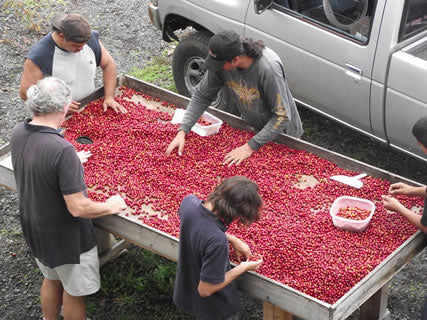Getting to Ripe Coffee at Hula Daddy Kona Coffee by Karen Paterson

During the first harvest on the Hula Daddy Kona Coffee coffee farm we noticed that the pickers were picking green, yellow, red, purple, brown and black coffee fruit. When we asked our manager why the pickers were picking fruit that was under and over-ripe we were told everyone did it and that the pulping process would remove the bad fruit. When we went to the coffee mill we found fruit from other farms that looked just like ours.

We talked to other farmers and they said that the University of Hawaii had determined fruit color didn’t make a difference in flavor. We looked for and found the publication the farmers were referring to:
“Sometimes pickers are permitted to harvest three types of cherry: green-ripe, or mature green, which is mature coffee although not fully ripe and has a yellowish-green skin; hard-ripe, which is firm and red (or yellow); and soft-ripe, which is overripe, red to dark red, soft, and juicy. These three types, or what might be called ripeness stages, were noted as early as 1937 to have similar cupping qualities in tests conducted at the CTAHR Kona Research Station. ” http://www.ctahr.hawaii.edu/fb/coffee/coffee_harvesting.html
Putting all of this information together for our first harvest, we accepted that it was OK to process coffee picked at different stages of ripeness. The same type of picking occurred in our second harvest.
By our third harvest, we were starting to have doubts about the quality of our picking. One thing we noticed is that many of the top quality farms in Central America employed sorters sitting at long moving belts to remove under and over-ripe coffee fruit before the pulping process. We also found publications by other universities that contradicted the University of Hawaii publication. So we decided to make our own tests.
First, we took a look at over-ripe beans. Pickers often don’t see soft spots on the back of ripe coffee fruit. Even if they see it, they still may put it in the basket. We were told that over-ripe beans float and the mills had water tanks that would float the over-ripe beans away from the pulper. So, we picked some beans that were “soft-ripe” ( had soft spots in them that were rotting). We mixed them in with some perfectly red-ripe beans and dropped them into a pail of water. The red-ripe beans sank to the bottom. The worst over-ripe beans floated and could be separated from the good beans. But the half-rotten beans stayed at the bottom with the good beans. So we were getting out some of the bad beans before they went into the pulper, but not all of them.
Second, we picked coffee fruit at five different stages of ripeness, green, yellow, yellow-red, red (hard-ripe) , and purple (hard-purple). We kept each stage separate and hand processed and roasted them. We didn’t use the red and purple soft-ripe beans because they were already rotting and you could smell it in the beans. We threw out the green sample because it wouldn’t ferment after we pulped it. We then had three coffee professionals, including a Q cupper, do a blind evaluation of the roasted coffee from each stage of ripeness. The blind assessments were remarkably uniform. The averages were:
Yellow |
83 |
Yellow-red |
89 |
Red |
91 |
Purple |
86 |
We concluded there was a significant difference between beans from red fruit and yellow fruit and a slight difference between yellow-red and red fruit. We were surprised by the drop off in the purple fruit since we expected the purple fruit to be more ripe and to have more flavor.
Third, we wondered what effect the sugar content of our coffee fruit would have on the taste. We had read that the sugar content of the coffee fruit was important to the final cupping characteristics.
“Sucrose is one of the compounds in the raw coffee bean that has been implicated as an important precursor of coffee flavour and aroma because it degrades rapidly during roasting, forming anhydro-sugars (such as 1,6 anhydro-glucose) and other compounds like glyoxal (De Maria et al., 1994). Such molecules are then able to react principally with amino acids (Maillard reaction) forming aliphatic acids, hydroxymethyl furfural and other furans, and pyrazine. These compounds are all considered to be essential contributors to coffee flavour….” Biochemical and genomic analysis of sucrose metabolism during coffee (Coffea arabica) fruit development , Journal of Experimental Botany, Vol. 57, No. 12, pp. 3243–3258, 2006 doi:10.1093/jxb/erl084
We had also read that Central American coffee farmers were using refractometers to measure coffee fruit sugar before picking. So, we took our yellow, yellow-red, red and purple coffee fruit and measured the brix content. The results were
Yellow |
3.6 |
Yellow-red |
13.9 |
Red |
19.5 |
Purple |
22.0 |

www.coffeegroot.com/2011/04/pick-ripe-coffee-cherries/
Based upon the research papers we read and our own unscientific experiments we concluded, at least for our farm, that:
1. Green, yellow, red (soft-ripe), purple (soft-ripe), brown and black beans are not acceptable.
2. A range of beans from at least half-red to purple (hard-ripe) is acceptable
3. We pay our pickers a premium to pick ripe coffee beans
4. We pick every week to get the coffee fruit we wanted.
5. We have to work at the sorting table to maintain the quality of the fruit.
We have done this now for two years. What has the result been? The good news is that our cupping scores have increased substantially. We now only sell retail and we have sold out of all of our coffees for the past two years. The bad news is that it is a lot of hard work and I often wake up during the night dreaming that I am sorting coffee fruit.
